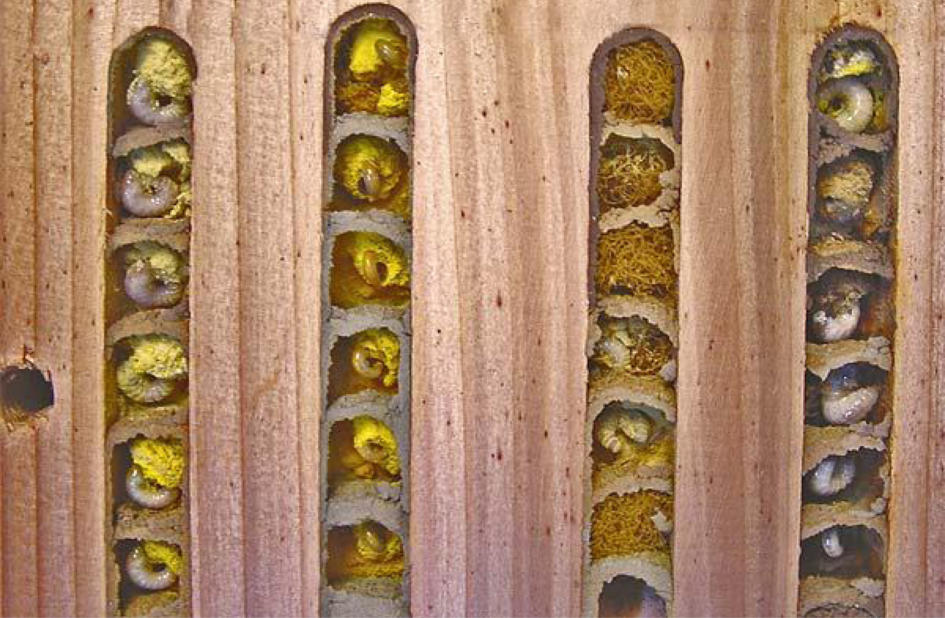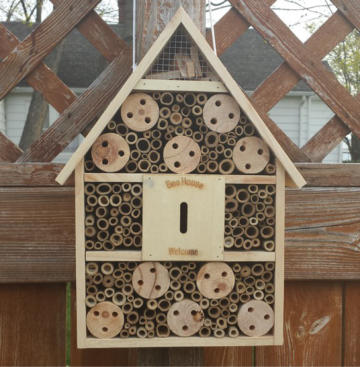Patterns and Native Bees
Bees are masters at building patterns. While we first might recognize the amazing hexagonal patterns honey bees build for their hives, did you know that honey bees aren’t native to BC? Today we’re going to learn more about native bees to BC, who build different, but equally impressive, patterns.
We have 4,000 species of native bees living in BC. You have likely seen them, but we often mistake them for flies or wasps. 90% of native bees are solitary. They are gentle as they have no need to protect a hive. Mason bees, leafcutter bees, sweat bees, and bumblebees are some of the native bee species in BC. These native bees will buzz around close to where they hatched, with most having a home area of only 300 metres. Some nest underground in tunnels or nest chambers that they create. Some are hole-nesting bees, nesting inside pre-existing holes in dead wood or broken stems.

Mason Bee Life Cycle:
(Similar for other solitary bees)
- Adult bees emerge in the early spring when temperatures are above 12° C.
- The bees mate and the female finds a place to lay her eggs.
- The female puts a mixture of pollen and nectar at the bottom of each cell for the developing bee to feed on. She caps each cell with mud.
- The larvae spin cocoons and become pupae, which develop into adults.The adults hibernate over the winter.
- The eggs hatch into larvae.
Native bees have a short life span of 4-6 weeks, and a big job to do in that time. They need to find a mate, find nest sites, lay eggs and collect enough pollen and nectar to feed the eggs they lay. Their entire metamorphosis happens inside their nest site. They go from egg, to larvae, to a pupae in a cocoon, all in the ground or a woody stem. The only time we see them is in their adult form as a bee.
Solitary bees, along with honeybees, are important pollinators.
(For a plant to grow seed, a flower must be pollinated). So how do native bees fit with patterns in nature? Let’s look at what’s inside the stem:

• Larvae / Pollen plug/ Clay/ Larvae / Pollen Plug / Clay
Do you see the pattern?
They make patterns when they lay eggs in the summer or fall for the next generation to emerge the following spring. What do they need to lay their eggs?
• Flowers
• Clay
• Somewhere to lay eggs – woody stems or habitat
Native bees are beneficial for our backyard food production and flowers. Wild bees are also suffering from pesticide and chemical use, habitat loss and disease. We can support our native bees by learning about them and helping protect them through making our yards more bee-friendly.

Here are some tips to encourage these friendly, amazing pollinators into your yard:
• Keep a section of your yard messy. Do not rake the fallen branches or rotten leaves, and leave the woody stems on old flowers. This provides undisturbed shelter spots for ground nesting bees, and old stems and hollow tubes for stem nesting bees.
• Plant a variety of trees, flowers and shrubs. It’s best if you have some plants that bloom in the early season, mid season and in late season. Trees and shrubs provide food and shelter for bees and a safe haven of an undisturbed area. Bees also love native flower species.
• Choose a chemical free yard.
• Provide nesting sites. Like birds, native bees will either find or create their own nesting site or use one that you provide for them. Nest sites can be as simple as a messy area where you leave woody stems on flowers and that you do not rake. Nesting sites can also be homemade or bought native bee houses.
• Provide water. Attached is a guide of to how to create bird baths that bees will also love. Leave puddles in your yard after it rains. You can also set out a pie plate or old bowl filled with rocks to collect rainwater. You can fill it from your house in dry times. Bees need shallow water so the rocks provide somewhere for them to perch on.
• Learn more and spread the word about BC’s native bees.
Want more? Build a bird and bee bath.








